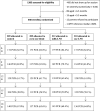Effect of dietary intervention on the prevalence of asymptomatic malaria among 6-18-month-old children in rural Malawi
- PMID: 37697296
- PMCID: PMC10496296
- DOI: 10.1186/s12936-023-04701-4
Effect of dietary intervention on the prevalence of asymptomatic malaria among 6-18-month-old children in rural Malawi
Abstract
Background: The complex interaction between malaria and undernutrition leads to increased mortality and morbidity rate among young children in malaria-endemic regions. Results from previous interventions suggest that improving nutritional status of young children may reduce the burden of malaria. This study tested a hypothesis that provision of lipid-based nutrient supplements (LNS) or corn-soy blend (CSB) supplementation to 6-18-month-old children in Malawi would reduce the prevalence of asymptomatic malaria among them.
Methods: A total of 840 6-month-old children were enrolled in a randomized trial. The participants received 12-month supplementation with three different daily dietary supplementations: CSB, soy-LNS, or milk-LNS, and one control group without supplementation. The prevalence rate of asymptomatic Plasmodium falciparum was determined by real-time PCR from the participant's dried blood spots (DBS) collected at the baseline and every 3 months. The global null hypothesis was tested using modified Poisson regression to estimate the prevalence ratio (PR) between the control group and three intervention groups at all ages combined. All the models were adjusted for malaria at baseline, season of DBS sample collection, site of enrolment, and household asset Z-score.
Results: All children combined, the prevalence of P. falciparum was 14.1% at enrollment, 8.7% at 9 months, 11.2% at 12 months, 13.0% at 15 months and 22.4% at 18 months of age. Among all samples that were taken after enrolment, the prevalence was 12.1% in control group, 12.2% in milk-LNS, 14.0% in soy-LNS, and 17.2% in CSB group. Compared to children in the control group the prevalence ratio of positive malaria tests was 1.19 (95% CI 0.81-1.74; P = 0.372) in the milk-LNS group, 1.32 (95% CI 0.88-1.96; P = 0.177) in the soy-LNS group and 1.72 (95% CI 1.19-2.49; P = 0.004) in the CSB group.
Conclusion: The study findings do not support a hypothesis that LNS or CSB supplementation would reduce the prevalence of asymptomatic malaria among Malawian children. In contrast, there was a signal of a possible increase in malaria prevalence among children supplemented with CSB.
Keywords: Asymptomatic malaria; Children; Dietary Intervention; Malawi; Prevalence rate.
© 2023. BioMed Central Ltd., part of Springer Nature.
Conflict of interest statement
The authors declare that they have no competing interests.
Figures
Similar articles
-
Lipid-based nutrient supplements do not affect the risk of malaria or respiratory morbidity in 6- to 18-month-old Malawian children in a randomized controlled trial.J Nutr. 2014 Nov;144(11):1835-42. doi: 10.3945/jn.114.196139. Epub 2014 Sep 17. J Nutr. 2014. PMID: 25332483 Clinical Trial.
-
Effect of complementary feeding with lipid-based nutrient supplements and corn-soy blend on the incidence of stunting and linear growth among 6- to 18-month-old infants and children in rural Malawi.Matern Child Nutr. 2015 Dec;11 Suppl 4(Suppl 4):132-43. doi: 10.1111/mcn.12068. Matern Child Nutr. 2015. PMID: 23795976 Free PMC article. Clinical Trial.
-
A lipid-based nutrient supplement but not corn-soy blend modestly increases weight gain among 6- to 18-month-old moderately underweight children in rural Malawi.J Nutr. 2010 Nov;140(11):2008-13. doi: 10.3945/jn.110.122499. Epub 2010 Sep 22. J Nutr. 2010. PMID: 20861218 Clinical Trial.
-
Effectiveness of food supplements in increasing fat-free tissue accretion in children with moderate acute malnutrition: A randomised 2 × 2 × 3 factorial trial in Burkina Faso.PLoS Med. 2017 Sep 11;14(9):e1002387. doi: 10.1371/journal.pmed.1002387. eCollection 2017 Sep. PLoS Med. 2017. PMID: 28892496 Free PMC article. Clinical Trial.
-
Preventive lipid-based nutrient supplements given with complementary foods to infants and young children 6 to 23 months of age for health, nutrition, and developmental outcomes.Cochrane Database Syst Rev. 2019 May 2;5(5):CD012611. doi: 10.1002/14651858.CD012611.pub3. Cochrane Database Syst Rev. 2019. PMID: 31046132 Free PMC article.
Cited by
-
Impact of asymptomatic malaria infection on children's growth in rural Malawi.Sci Rep. 2025 Aug 1;15(1):28094. doi: 10.1038/s41598-025-13331-6. Sci Rep. 2025. PMID: 40750634 Free PMC article.
References
-
- World Health Organization . World malaria report 2021. Geneva: World Health Organization; 2021.
-
- WHO. Test, treat, track: scaling up diagnostic testing, treatment and surveillance for malaria. Geneva, World Health Organization; 2012. Report No.: WHO/HTM/GMP/2012.03. https://apps.who.int/iris/handle/10665/337979
Publication types
MeSH terms
LinkOut - more resources
Full Text Sources
Medical
Research Materials


